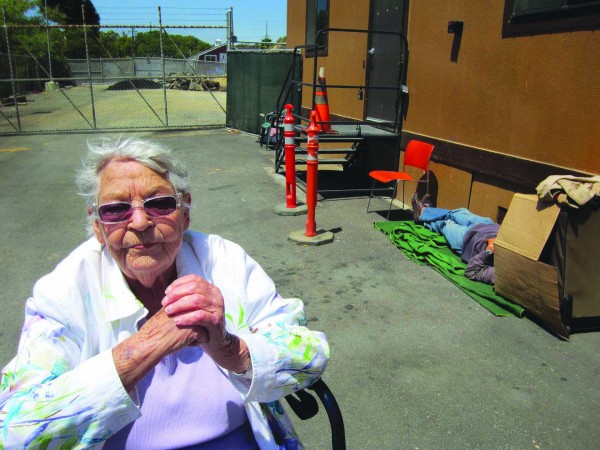
Take someone who is living under a tree (someone with a mental health disability that triggers their chronic homelessness), give them a place to live, and then provide support services to help them remain stable there. Thus, Helen Cameron offered a nutshell description of permanent supportive housing.
She should know. Cameron founded Homes, Inc. in 1985, the county’s first permanent supportive housing provider, which has since merged with Irvine’s Jamboree Housing Corp. The latter, in alliance with Laguna Beach’s Friendship Shelter, took the wraps off a conceptual plan this week for a $13 million permanent supportive housing development in Laguna Beach.
Staking of the proposed structure in Laguna Canyon took place this week to give locals a chance to gauge the scale of the project. A City Council hearing on the proposal is scheduled for April 22.
In a press conference this week, principals laid out financing prospects and benefits of the long-envisioned 40-unit facility they hope to build on city-owned land at 20652 Laguna Canyon Road, now occupied by a city-run homeless shelter operated by the Friendship Shelter. The parcel is sandwiched between the dog park and the Pacific Marine Mammal Center.
“Our intent is to have a transparent and honest conversation with the community,” said Friendship Shelter’s executive director Dawn Price, explaining the effort to publicly disclose conceptual plans prior to formally submitting a development application.
Staking is based on loose parameters and not an actual design, said local architect and builder Marshall Ininns, Friendship Shelter’s board president.
The building, though, will be set back the required 25 feet from the creek, said Ininns, on property that is already zoned for industrial use, though supporters will need to apply for the requisite conditional use permit for residential housing, special needs. Ininns noted that the usable space in the parcel amounts to less than two acres.
According to Price, in addition to the single-occupancy residential units, the new structure would also continue to provide the local homeless population with a place to sleep overnight and shower, as the shelter now does, but at a lower cost to the city, saving them about $150,000, which amounts to almost half of the current operating expenses.
If the project comes to fruition, the partners predict the volume of people seeking temporary shelter may go down. The 300-square-foot efficiency units would end homelessness for 40 people.
Taking these people off the street and providing them support tends to result in less emergency medical care and law enforcement calls, a side benefit to taxpayers, Price pointed out.
The homeless shelter served 326 different people who spent at least one night at the shelter last year, she said. Yet, 70 percent of the space is routinely occupied by the same 44 individuals, who could benefit from the proposed program, she said.
Jamboree estimates the project’s cost at $13 million, or $330,000 per unit, said Mary Jo Goelzer, chief operating officer of the nonprofit.
Since 1990, Jamboree has developed affordable housing for low income families, seniors and special needs group that houses 17,000 people in over 70 residential communities, including successful permanent supportive housing ventures, such as Diamond Aisle apartments in Anaheim.
Likely funding will come from some combination of federal, state and local county agencies, as well as investment equity from tax-credit seeking investors, Goelzer said. And the partners expect to secure a grant under the Mental Health Services Act, jointly administered by the state’s mental health and housing finance agencies. The housing program offers subsidies for permanent supportive housing serving the mentally ill homeless population.
The Friendship Shelter has also committed to launch a capital campaign to help finance the project.
From the city, partners would like an exclusive right to develop the property for about three years while they flesh out the project, Price said. And if the partners can obtain financing and get their plans approved, they hope to lease the land from the city at a nominal rate.
Goelzer said that between Jamboree and Friendship Shelter, along with other community partners, they should have no problem supplying supportive services to the residents.
“It is very much a team effort to make this kind of project work,” said Cameron, who advised both of the city’s previous task forces on homelessness. She said that their 98 percent success rate in keeping people housed far exceeds the federal success rate for similar programs.
Just like any other renters, permanent supportive housing residents typically sign a rental agreement, said Cameron, thereby agreeing to rules and expectations. Rent is set at no more than 30 percent of their income, which is typically a government stipend of at most $815.
Rental income would pay for most operating costs, said Goezler, with the remainder paid by subsidies expected from MHSA.
Support services focus on case management and mental health services, both onsite and offsite, to assist with a range of needs, said Cameron. Geared toward enhancing stability, these might include substance abuse services to help residents remain sober, assistance in finding part-time employment, or helping residents to keep their units in order so as to pass safety inspections.
Cameron explained that resident selection generally hinges on the funding source. For example, Orange County Housing Authority maintains a list of people seeking affordable housing and might refer those on their list who met the criteria for permanent supportive housing of being chronically homeless with a mental health disability.
Though referrals can include people from anywhere in the county, “We will do whatever we can to ensure that we help our local folks,” said Price, who said partners have already been assisting the local homeless with signing up for various available programs, so that their names come up on the housing lists of the various funding agencies.
Though Laguna’s homeless population is about .8 percent of the county’s homeless, estimated at about 67 individuals at any given time, it is largely made up of the chronically homeless, including many suffering from disabling mental conditions, according to the partnership’s Friends of Supportive Housing website. They claim this bucks the national trend, which shows that nationwide families with children and the working poor make up the vast majority of the homeless.
Price has already met with representatives of the Food Pantry, adjacent to the existing shelter, and PMMC and plans to talk to nearby neighborhood associations and the Canyon Club, which holds support meetings for recovering alcoholics.
Having the Canyon Club, “just steps away is really exciting for me,” said Price, since once the basic need for shelter is met, residents often progress to addressing disabling addictions. And, of course, proximity to the Food Pantry, is another boon, she said.
The partners cite permanent supportive housing as the widely-accepted, national best-practice in homeless services for its success in providing a solution for the chronically homeless with mental disabilities.
“We really applaud Laguna Beach for taking steps to provide a long term solution,” said Cameron.
Laguna Beach is believed to be one of the smallest communities to address homelessness in this way.
The partners have established a website with information about the project, a list of FAQs and a place to add your name to the list of supporters.
The permanent supportive housing project would add to the Friendship Shelter’s three existing programs, including their self-sufficiency program helping homeless individuals to re-enter the workforce and begin supporting themselves; their day-to-day operation of the city’s homeless shelter; and their just-launched, scattered-site supportive housing program.
Price said that from the beginning the Friendship Shelter, founded 26 years ago, has wanted to work with the most vulnerable people in the community, and that for this subset of mentally disabled chronically homeless, permanent supportive housing is really the only solution. To that end, the Friendship Shelter in 2009 set a goal of making it part of their strategic plan and they have been working toward it ever since. With the approval of their joint proposal with Jamboree, they may attain their goal.





So there is a plan to build low income housing and more homeless sheltering in the canyon? Where can I go to vote for this project to fail?
[…] $13 million joint proposal comes from Laguna’s Friendship Shelter and Irvine’s Jamboree Housing Corp. Their plan […]
[…] at 1335 S. Coast Highway. Friendship Shelter has unsuccessfully approached Laguna to build its own permanent supportive-housing for chronically homeless […]
[…] you; he doesn’t pound the table,” Boyd said. Though Henderson made it known that his goal, to establish permanent housing with support services for the town’s chronic homeless, was more ambitious than that of the task […]